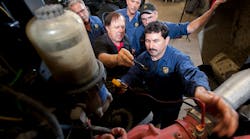UPS is in business to synchronize the world of global commerce. To that end, they deliver more than 15 million packages a day to more than 7 million customers traveling 3 billion miles per year. It’s a logistical ballet that relies heavily on an automotive fleet that numbers more than 100,000 vehicles.
Those vehicles range from what UPS calls “package cars,” the ubiquitous brown stepvans, to tractor trailers, with a very wide variety of vehicle types, brands and models. UPS also operates one of the nation’s largest fleets of alternative fuel and hybrid vehicles.
Properly maintaining its massive fleet is critical to the company’s success, and it has recognized this since it plied the streets of Seattle with Model T’s in the early 1900s. Globally, UPS has some 5,000 technicians stationed at nearly 1,800 maintenance facilities.
Just as it has with its army of iconic brown-clad drivers, UPS has developed its own methods and procedures for the maintenance of its fleet. The company is increasingly using technology to capture vehicle data which is analyzed in order to make improvements in fleet maintenance and repair processes.
TECHNICIAN RECRUITMENT
Regardless of how good any maintenance program is, it will not produce results if there are not capable and qualified technicians to do the work.
When recruiting technicians, there are specific things UPS looks for. Once hired, UPS has a highly structured methodology for training and development.
UPS has found that certain key criteria improves its success rate in hiring and retaining technicians, says Vic Mariano, the company’s corporate automotive training manager.
It looks for technicians who have most, if not all, of the following qualifications:
- A minimum of five years of heavy truck experience.
- Are experienced with computers, scan tools and diagnostic equipment.
- Are able to work various shifts, especially nights, because that is when repair and maintenance of much of the company’s fleet takes place.
- Have a commercial driver’s license and a clean driving record.
Technician certifications, such as ASE, are not required, but are a plus. So are college degrees and continuing studies. “Because we often promote from within at UPS, there are opportunities to move into management,” Mariano says, and notes that he started his career with the company 32 years ago as a technician.
Like others companies, UPS uses a host of methods to recruit technicians. All can be effective depending on each situation, he says. Most often, the strongest candidates have come from referrals from technicians who work at UPS.
CONTROLLED PROCESS
The vehicle technician job at UPS is very structured, with assigned fleets and weekly work schedules that are planned by the supervisor and technician to ensure the work is prioritized properly to make the most efficient use of the technician’s time.
The foundation of UPS’s technician training is what it calls the Pre-Seniority Training Period - essentially a “try-out” for a technician to make the UPS team. It’s an extensive program that averages 45 days.
The Pre-Seniority Training Period is a well-defined process aimed at taking a new hire through several distinct elements of training. It begins with an “introduction” to the company and its history, then covers business conduct, procedures and policies at UPS.
Next comes safety training and regulatory compliance, which includes all applicable OSHA, DOT and EPA rules and regulations. “Safety and safety training is paramount and ongoing at UPS,” Mariano says.
When safety and regulatory compliance training are complete, managers start to evaluate a new technician’s skills and qualifications. Progress reviews are done weekly throughout the training period.
These reviews are very important to let the technician know how they are progressing, as well as to review positive points and areas the technician may need to focus on.
“Our Pre-Seniority Training gives the new technician a feel for what it’s like to work for UPS,” he says. “Just because we hire a person as a technician, the position may not be a good fit for him or her so it works both ways. We get a chance to evaluate the individual, and they get a chance to evaluate the job.”
PMI METHOD
The next element of the Pre-Seniority Training Period is preventive maintenance inspection (PMI) training. “The preventive maintenance program at UPS is the backbone of our whole operation,” emphasizes Mariano. “With effective preventive maintenance, we’re able to have minimal vehicle breakdowns on the road. That means we deliver our customers’ goods on time, and that means we’ve kept our promise.”
For UPS’ PMIs, in addition to checking components required by the DOT, there is a prescribed method for completing them, he explains. “The level of detail we go into for our PMIs, which require several hours to conduct, is key to our vehicle reliability and helps keep our operational costs manageable.”
Regardless of their experience, all new technicians at UPS are trained and certified on the UPS PMI process during the Pre-Seniority Training Period.
Just as it does with its drivers, UPS assigns its technicians the same vehicles to work on. By doing this, the technicians “get more familiar with the vehicles and take ownership of their fleet,” says Mariano. “It becomes a matter of pride in keeping their fleet in top shape.”
As with everything at UPS, vehicle reliability, maintenance expense and technician performance are constantly measured.
DIAGNOSTIC SKILLS
Evaluating a new technician’s ability to diagnose the source of a problem quickly and accurately, along with their mastery of repair skills, is another aspect of the Pre-Seniority Training Period. Technicians are observed by their supervisor as they diagnose a problem, set up for the job and then make the repair. This is done on the shop floor, rather than in a classroom with mock-ups or training displays.
“The problems are real-life and done on active fleet vehicles,” Mariano says. “When we hire a technician, it’s not as if they are an extra person on the shop floor. We need them to contribute quickly to keep the maintenance program on track. After the safety and PMI training and certification, we get them going right away and observe how they do.”
There are a handful of key repairs - brakes repairs, replacing a clutch or transmission, diagnosing vehicle electrical problems, for example - on which technicians are evaluated to make certain they have the required skill level to properly and effectively complete the repair.
In addition, new technicians receive training on the emerging technology of telematics and condition-based maintenance. Condition-based maintenance offers proactive notification of impending vehicle component failure.
Once a new technician successfully moves through the Pre-Seniority Training Period they gain their seniority and join the UPS team. Technicians at UPS are union employees.
GOOD START
UPS works hard to get technicians off to a good start. The technicians know early on what is expected of them. Plus, they are given all the procedures and policies they need to follow, along with the necessary beginning training.
“With all this, they can have a long, productive career at UPS,” says Mariano.
He notes that technicians tend to stay a long time at UPS. “There is very little technician turnover. We offer a competitive pay and benefits package, and we work hard to make UPS a good place to work.”
CONTINUAL EDUCATION
Recurrent training is done annually at UPS, which includes safety training and all training required by regulatory agencies.
“Continual education and training is very important in order to stay current on what is happening in the industry, on the regulatory front and with new vehicles and technology,” Mariano says.
Company-wide, about half of all the training at UPS is devoted to safety. That amounts to $175 million every year.
UPS also provides web-based training for its technicians. UPS maintains a large online library of training materials for its technicians through its own Learning Management System.
UPS also takes advantage of manufacturer-supplied training and uses outside trainers as well.
TARGETED TRAINING
“Because some of our vehicles are used for 20-plus years, there is the challenge of keeping technicians up-to-date on new vehicles and vehicle technology,” says Mariano. “When we buy new equipment, part of our process is to have suppliers include training with the purchase.
“Our new vehicles often get spread out nationwide, so it’s difficult to get everybody trained on every new piece of equipment. But our goal is to make sure all technicians are at least familiarized with the main features and differences, and understand the key things they need to know to maintain any new vehicle.”
Because trucks in general have become more reliable, UPS can delay the roll-out of some in-depth new vehicle training until the trucks have been in use for a while. “Otherwise, technicians could forget the course content since it may take a year or so for some repairs to be necessary,” he says.
However, targeted training is done when and where needed, say when a facility gets new hybrid or electric vehicles.
UPS also does initiative-based skills training when the company deems it necessary. This could be when a company-wide issue arises with electrical systems, or if a new diagnostic tool is rolled out, or if there is the need to implement some business initiative.
In such instances, UPS will develop training sessions that address the concern or initiative. This could be online, hands-on or a blended solution - whatever is the most effective way to deliver the training is done.
In addition to training on vehicle repairs and maintenance, UPS also provides training on shop test equipment. “Because we have such a diverse fleet, our technicians need to be proficient on all types of scan and diagnostics equipment,” he says.
TRAINING ROI
“Our goal is to get immediate feedback on training course content and delivery,” says Mariano. “From there we measure application of learning in different ways, including testing or observation. The measure of effectiveness of any training program is how it contributes to the bottom line results.
“It may not always be a purely financial measurement,” he notes. “It may be vehicle reliability, technician safety or cost per mile.
“However, we know without a doubt, training contributes to helping us reach our goals. We couldn’t be where we are today as a company without an effective training component.”
Mariano points out that the technicians at UPS “know they’re an integral part of the on-time delivery of packages. We’re in the business of satisfying customers. The ultimate goal of everyone at UPS is perfect service.
“The job of the UPS technician is to keep our vehicles in service, keep our drivers’ wheels moving and help us keep our promise to our customers. That’s how we roll.”




